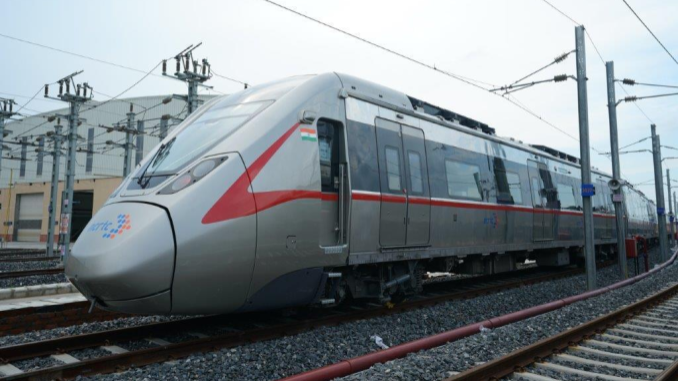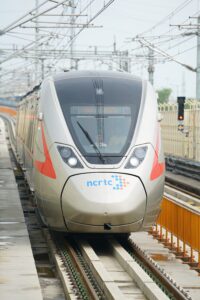
Alstom, global leader in smart and sustainable mobility, reached a milestone for India’s rail revolution with the inauguration of RAPIDX with its rolling stock and signalling solutions provided by Alstom India.
More Details:
India’s first semi-high-speed regional rail service was flagged off by the Hon’ble Prime Minister Shri Narendra Modi alongside the Chief Minister of Uttar Pradesh, Shri Yogi Adityanath and other government dignitaries. The first phase i.e., the Duhai-Sahibabad section (17 kms) of the Delhi-Meerut corridor which will be operational from 21 October for the general public also marks the world debut of the Level 3 ETCS (European Train Control System).
This will not only contribute to safety, but also will facilitate interoperability, reduce wait time and enable efficiency. It will be equipped with Automatic Train Operation (ATO) over Long Term Evolution (LTE) in the future to further increase in network performance and capacity.
Designed and manufactured in India, the RAPIDX reinstates Alstom’s commitment to Atmanirbhar Bharat with end-to-end engineering, manufacturing and signalling work done in India. In the last two years, Alstom’s 360+ engineers & designers devoted thousands of hours and ran hundreds of hours of tests to deliver the phase-I commitments to National Capital Region Transport Corporation Ltd. (NCRTC). The company is aiming to also achieve its delivery commitments by 2025.
Commenting on this landmark moment, Mr. Olivier Loison, Managing Director – Alstom India said, “It is a moment of pride for us at Alstom to yet again be a part of India’s Rail Revolution. RAPIDX will be a first-of-its-kind experience for Indian commuters for its speed, advanced technology and passenger experience. This project also marks the world premiere of several new signalling technologies which will set new benchmarks in the rail space globally. All of this is set to make sustainable mobility at scale real in India. These Made in India trains reflect our robust capabilities, and we are truly humbled to be contributing to India’s rail-based infrastructure growth.”

World debut of signalling technologies towards modernisation and improved efficiencies:
- Alstom India is making the world debut of European Train Control System (ETCS) Level 3 signalling, with integrated Platform Screen Doors using Long Term Evolution (LTE) communication with the RAPIDX. These solutions are designed and stacked together to provide utmost safety to passengers.
- A key feature of the technology being introduced in RRTS is interoperability, which facilitates seamless commuter movement across the corridors, without the hassle of changing the trains for passengers. ETCS signalling system will not only facilitate interoperability but will also allow optimisation of the usage of existing infrastructure, thus reducing the waiting time for passengers.
- This signalling system provides a high level of safety for trains running at close headway of 180 seconds by virtual block implementation (hybrid level 3) to ensure continuous and safe separation and eliminates accidents due to human error. This service also comes with Automatic Train Protection (ATP), Traffic Management System (TMS), Platform Screen Door (PSD) sub-systems using Long Term Evolution (LTE) communication between track side and train.
A one-of-its-kind ‘Make in India’ marvel:
- Designed at Alstom’s Hyderabad engineering centre and manufactured at Savli (Gujarat), these trains perfectly align with the government’s Make-in-India and Aatmanirbhar Bharat ambition. The rolling stock is based on Alstom’s Adessia commuter train family, incorporating worldwide experience. The propulsion systems and electricals are manufactured at the company’s factory in Maneja (Gujarat).
- The RAPIDX will play a key role in promoting balanced and sustainable economic development of the region. The advanced, eco-friendly design will bring significant efficiencies through the incorporation of energy-saving technologies, including the modern car body, reliable bogies, efficient propulsion system and regenerative braking.
- Outstanding ergonomics, safety and comfort, low life cycle costs and high recyclability also contribute to making these new commuter trains an attractive sustainable choice to promote public transport, thereby reducing traffic congestion, air pollution and fuel consumption. They help to save travel costs and time as well as to change the lives of millions of citizens by connecting suburban places with the economic centre of the region.
Alstom and RAPIDX project commitment:
In 2020, Alstom was awarded the contract and the scope of work includes:
- Design, build, and deliver the train sets. Delivery of 210 commuter and transit train cars.
- Design, supply and install the signalling, train control and telecommunication system, platform screen door & long term evolution which is completed for the ~ 17km priority section for the launch.
- Provide comprehensive maintenance services for 15 years.
The primary purpose of this Regional Rapid Transit System (RRTS) is to relieve the traffic congestion in the national capital and de-urbanise the city by allowing faster commute between nearby satellite towns. Since 2002, after the opening of the 1st section of DMRC, the metro network has grown at a rapid pace. The RRTS network will complement the metro and is expected to grow very fast in the country.
Alstom designed the train inspired by Delhi’s iconic monument, the Lotus Temple, and unveiled it in September 2020. It is a game changer in the commuter and inter-regional rail transport space which is set to change the way India travels.
Regional Rapid Transit System (RRTS) is a new, dedicated, high speed, high capacity, comfortable commuter service connecting regional nodes in NCR. There are eight RRTS corridors planned. The first one between Delhi and Meerut will be called RapidX.
Source: Alstom- Press Release | Images Credit: Alstom

